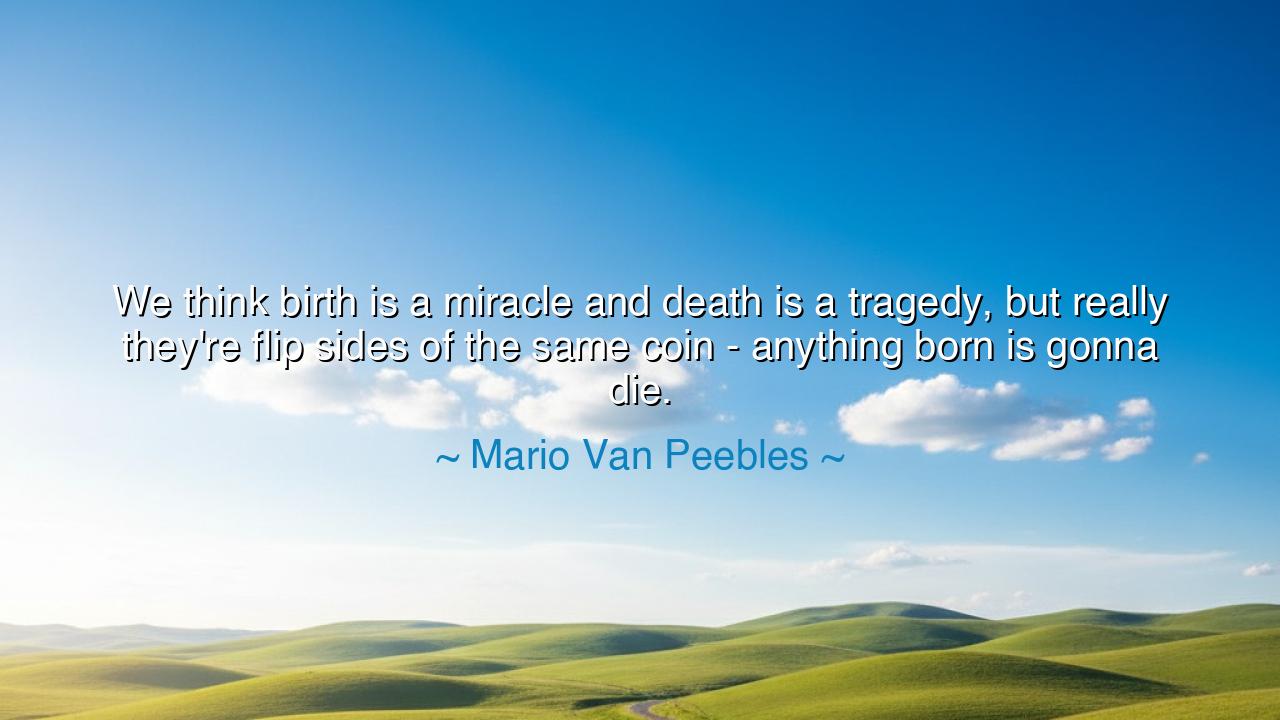
We think birth is a miracle and death is a tragedy, but really
We think birth is a miracle and death is a tragedy, but really they're flip sides of the same coin - anything born is gonna die.






The filmmaker and philosopher Mario Van Peebles once spoke words that pierce through the illusion of time itself: “We think birth is a miracle and death is a tragedy, but really they’re flip sides of the same coin — anything born is gonna die.” In this single reflection lies the eternal rhythm of existence, the cycle of life and death that all things — from stars to souls — must obey. What he calls the “same coin” is the mystery that binds all creation together: that life and death are not opposites, but partners in an endless dance.
From the ancient days, the wise have known that birth and death are not two events, but one continuous unfolding. The river that springs joyfully from the mountain already carries within it the memory of the sea into which it will one day return. So too with human life — the first cry of an infant is also the first step toward silence. The ancients accepted this truth not with despair, but with reverence. To be born was sacred; to die was to be released. It was the modern mind that began to fear one and worship the other, forgetting that both are necessary to the music of existence.
Van Peebles’ words remind us that mortality is not a curse but the very condition that gives meaning to life. If the flower did not fade, we would never pause to admire its beauty. If the sun never set, we would not cherish its light. The miracle of birth lies not in its defiance of death, but in its harmony with it. What we call tragedy is merely transition — the passing of one form into another. The ancients saw this in the seasons: spring’s blossom, summer’s fullness, autumn’s fall, and winter’s stillness — each a necessary chapter in the eternal story of being.
Consider the life of the Buddha, who, as a young prince, lived shielded from the sight of sickness and death. When he finally saw an old man, a sick man, and a corpse, his heart broke with realization: that all living things are bound by impermanence. This understanding did not make him despair — it made him wise. He left behind luxury and sought enlightenment beneath the Bodhi tree, where he saw that all suffering arises from our resistance to the natural law of change. To know that “anything born is gonna die” is not to lose hope, but to see clearly — to love deeply without clinging, to live fully without fear.
The origin of Van Peebles’ insight lies in the very human struggle to reconcile joy and loss. As an artist and storyteller, he understood that the power of creation is inseparable from destruction. Every film he made, every story he told, was born from his awareness of time — of how fleeting beauty is. The actor’s performance ends; the stage lights fade; the applause dies — but what remains is the truth that each moment, though impermanent, is infinite while it lasts. This is the wisdom of all creators: to honor life because it passes, not despite it.
When he says that birth and death are two sides of the same coin, Van Peebles speaks of unity — the sacred wholeness of existence. Just as day gives way to night and night to dawn, so too must we accept the rhythm of our own being. The coin cannot have one side without the other. To rejoice in birth but curse death is to love only half of life. The wise learn to bow before both — to celebrate beginnings and to release endings with grace. For to die is not to vanish, but to return to the great source from which all life arises.
So let this be the lesson: do not fear the end, nor cling too tightly to beginnings. Instead, live with awareness of both — with gratitude for the breath that enters and the one that departs. See the miracle not only in birth, but also in transformation. When a loved one passes, grieve, but also remember: they have crossed into the same current that once carried them into being. And when you yourself face that crossing, walk with courage, knowing that you are returning home.
Thus, the words of Mario Van Peebles echo like an ancient teaching: that life and death are not enemies, but eternal companions. The coin spins between them endlessly, gleaming with light and shadow. To understand this is to live in peace with time itself. So go forth — cherish what is born, honor what dies, and hold them both in your heart as one. For this, truly, is the secret of harmony: to see the miracle not in the beginning or the end, but in the sacred wholeness of the journey.






AAdministratorAdministrator
Welcome, honored guests. Please leave a comment, we will respond soon